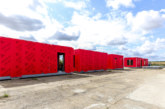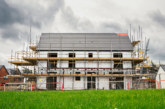Zisis Nikoloudis, Segment Manager – Commercial at Uponor, discusses the Government’s ambitious carbon emission targets and offers advice on greener ways to heat tall buildings.
Boris Johnson’s announcement that the Government aims to cut carbon emissions by at least 68% by 2030 is a bold new milestone towards its goal of achieving net-zero carbon status by 2050. As the construction industry accounts for around one third of all emissions, the Government is setting increasingly demanding benchmarks to ensure that the sector meets its ambitious environmental targets.
Due to the fact that the heating and cooling of residential buildings generates significant emissions, this part of the industry is coming under particular pressure to change. This is well illustrated by the Future Homes Standard, which recommends that by 2025 no new homes should be connected to the gas grid, and should instead utilise low carbon solutions such as district heating networks and renewable energy sources. Adding further pressure, the recent ‘green industrial revolution’ plan indicated that this deadline could be moved forward to 2023.

Tall targets for tall buildings
With these targets, it’s important to bear in mind that not all homes are the same. For example, the large amount of resources required to build and operate tall buildings means they’re coming under closer scrutiny. How we reduce the carbon footprint of these developments is going to become even more of a focus the nearer we get to the target dates.
Yet despite deadlines looming, many construction industry professionals are highly sceptical about the sector’s ability to meet them. When we surveyed 200 construction industry professionals on the challenges facing high-rise construction, over three quarters said that these goals will not be achieved without significant changes in the approach to retrofitting existing homes and developing new homes. When it came to the issue of disconnecting new homes from the gas grid, only half thought that the 2025 deadline would be feasible while 10% did not think that it would ever be possible.
To help combat this scepticism, we’ve looked into one of the key areas flagged as a concern by our research respondents — product knowledge — and have focused on one system in particular which is going to play an increasingly important role if we’re to cut emissions with sustainable heating and domestic hot water technologies.

District heating networks
While district heating networks have been steadily growing in popularity over recent years, still only around 3% of the UK’s heat demand is supplied by such networks. This is a figure which the Committee on Climate Change has said needs to rise to at least 18% if the UK is to meet its carbon targets, and local authorities will be one of the sectors to lead the charge towards this sustainable way of heating.
Research shows that replacing conventional heating with district heating networks connected to renewable energy sources can significantly improve a building’s energy efficiency levels. This has seen the UK Government incentivise its use in a number of ways, such as the Heat Network Investment Project and the Renewable Heat Incentive.
In practice, district heating networks typically consist of a centralised energy centre that uses an underground network of pipes to supply heat and hot water. We see this type of solution as particularly useful for tall residential buildings, as only one heat source is required for multiple properties. The ability to connect a district heating network to a renewable energy source, such as air source (ASHP) or ground source heat pumps (GSHP), and combine it with insulated piping makes this a very environmentally friendly heating option, avoiding the need for additional energy generation and minimising energy losses.
Renewable energy sources, such as GSHP, ASHP and solar thermal power, are highly efficient and on average last longer than conventional boilers, delivering lifecycle cost-savings. Using insulated pipes to carry water to and from the energy source and residences maximises the system’s efficiency by minimising heat and energy losses. High performance, pre-insulated pipes that are able to bend and flex with the natural ground conditions add further longevity to the system by limiting the number of joints and connections, thereby reducing the likelihood of leaks.
Overall energy efficiency can also be improved by implementing alternative heating solutions such as radiant heating systems, radiant panels and underfloor heating, which operate at lower temperatures compared to conventional systems. We also often advise smart energy management technology, such as smart heating controls, which can further enhance a development’s energy efficiency levels.

New ideas to tackle old problems
The key sustainability hurdles identified in our research included a combination of demanding targets, an ongoing skills shortage and a lack of awareness regarding sustainable options. This indicates the sector is going to have to make some major alterations to how it operates if net-zero construction is going to be possible.
This change may only just be around the corner though, as alongside increasing the use of systems such as district heating networks, ways of specifying and designing are coming to the fore, which will help the industry improve. This includes the advanced seventh dimension of BIM, which will see sustainability information on each building product incorporated into the design. Manufacturers and industry associations are also looking for new ways to provide advice, such as through the creation of Environmental Product Declarations, which help identify products with the least environmental impact. Similarly, we recently worked with the British Plastics Federation on bulletins that analysed the environmental considerations of different hot and cold-water supply systems.
By embracing the right technologies and encouraging the industry to better collaborate and communicate in order to share important information, skills and ideas, then the sector has the chance to meet its environmental obligations.









